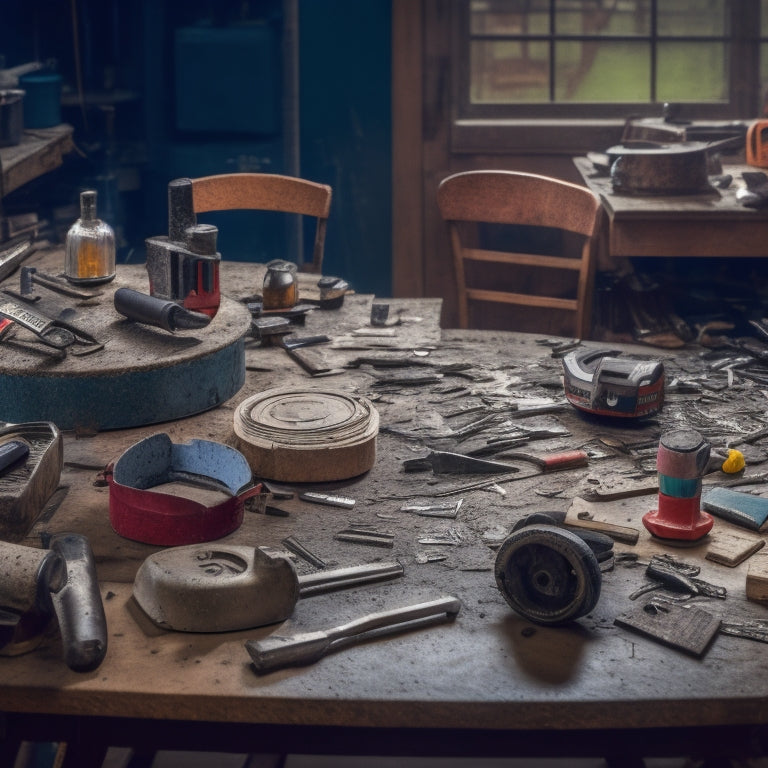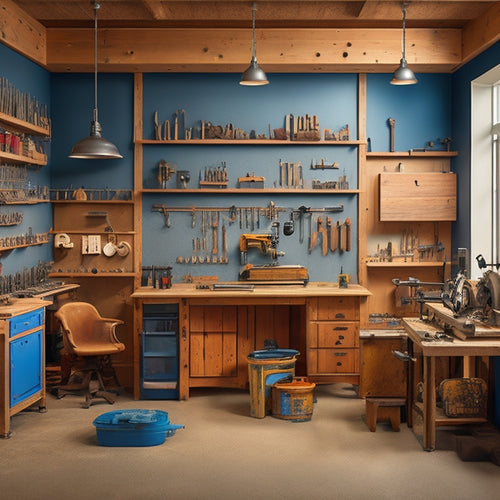
What Blade Do I Need for My Renovation
Share
When it comes to your renovation project, choosing the right blade is vital for efficient cutting, safety, and best results. You'll need to take into account the type of cut you need to make, the material you're working with, and the power tool you're using. For concrete cutting, you'll need to decide between an abrasive blade or a diamond blade, each with its strengths and weaknesses. Additionally, you'll need to verify the blade diameter exceeds the slab thickness, and the arbor size matches your power tool. By understanding these factors, you'll be well on your way to selecting the perfect blade for your renovation project, and a few more key considerations can make all the difference.
Key Takeaways
• Determine the type of material you're cutting (concrete, asphalt, metal) to choose between abrasive or diamond blades.
• Ensure the blade diameter exceeds the slab thickness by at least 1/4 inch for optimal performance and safety.
• Select a blade with a compatible arbor size and power tool specifications to avoid hazards and inefficiencies.
• Consider the surface condition, potential obstructions, and desired cut quality when choosing a blade type and cutting technique.
• Verify the blade's certification and compliance with safety standards (OSHA, ANSI, CE) to minimize risks during renovation projects.
Understanding Concrete Blade Types
When selecting a blade for your renovation project, you'll need to navigate the diverse range of concrete blade types, each designed to tackle specific tasks and materials. Understanding the characteristics of each blade type is vital to achieving the best results and extending the life of your blade.
For instance, abrasive blades are ideal for cutting through concrete, asphalt, and metal, while diamond blades are better suited for precision cutting and finishing. You'll also need to take into account the bond type, which affects the blade's aggression and speed.
To get the most out of your blade, it's important to master cutting techniques, such as using the correct cutting angle and applying consistent pressure. Additionally, regular blade maintenance tips, like cleaning and inspecting the blade after each use, can greatly prolong its lifespan.
Measuring Your Concrete Slab
You'll need to accurately measure your concrete slab to determine the correct blade size and guarantee a successful renovation project. This step is essential, as using the wrong blade can lead to poor performance, reduced lifespan, and even safety hazards.
To measure your concrete slab, follow these steps:
-
Determine the slab thickness: Measure the thickness of your concrete slab to make certain you choose a blade that can handle the depth. This will also help you decide on the appropriate arbor size.
-
Assess the surface condition: Evaluate the surface of your concrete slab, taking note of any cracks, rough patches, or other imperfections. This will help you choose a blade with the right aggressiveness and bonding system for the job.
-
Identify any obstructions: Check for any obstructions, such as rebar, that may affect the cutting process.
Choosing the Right Blade Size
With your concrete slab measurements in hand, select a blade that matches the slab's thickness and your renovation goals, guaranteeing a precise cut and ideal performance. A blade that's too small will lead to inefficient cutting and increased wear, while one that's too large will compromise accuracy and safety.
When choosing the right blade size, consider the following blade selection tips: the blade's diameter should be at least 1/4 inch larger than the slab's thickness to guarantee a clean cut. Additionally, the arbor size, which is the hole in the center of the blade, must match your saw's arbor to guarantee proper fit and safety.
Renovation project considerations, such as the type of cut you need to make, also play an essential role in blade selection. Are you making straight cuts or curved cuts? Do you need to cut through rebar or other obstructions?
Answering these questions will help you determine the ideal blade size and type for your project. By selecting the right blade size, you'll achieve professional-looking results, reduce downtime, and get your renovation project back on track.
Diamond Blade Vs Abrasive Blade
When selecting a blade for your renovation project, you'll need to decide between diamond blades and abrasive blades.
You're choosing between a blade that cuts with bonded diamonds or one that uses abrasive materials to grind through materials.
Understanding the differences in blade material and cutting action will help you make the right choice for your specific needs.
Blade Material Matters
Selecting the right blade material is essential for achieving ideal results in renovation projects, as it directly impacts the quality of the cut, tool longevity, and overall efficiency. You want a blade that can handle the demands of your project, and choosing the wrong material can lead to subpar results and increased costs.
When it comes to blade material, you have two main options: diamond blades and abrasive blades. Here are some key differences to evaluate:
-
Blade Durability: Diamond blades are considerably more durable than abrasive blades, making them ideal for heavy-duty projects. They're less prone to wear and tear, which means you'll spend less time on blade maintenance.
-
Cutting Speed: Abrasive blades are generally faster than diamond blades, but they can also be more aggressive, which can lead to a rougher cut.
-
Material Versatility: Diamond blades are better suited for cutting through hard materials like concrete and asphalt, while abrasive blades are better for softer materials like wood and drywall.
Cutting Action Compared
Cutting Action Compared
Examine the cutting action of diamond blades and abrasive blades, and you'll notice distinct differences in their performance and suitability for specific renovation tasks. Diamond blades use a grinding action, where the diamond-coated rim wears down the material, producing a clean cut. Abrasive blades, on the other hand, use a tearing action, where the abrasive particles scrape away the material. This fundamental difference affects the cutting techniques you'll use and the blade maintenance required.
| Blade Type | Cutting Action | Suitability |
|---|---|---|
| Diamond | Grinding | Hard materials (concrete, asphalt) |
| Abrasive | Tearing | Soft materials (wood, drywall) |
| Diamond | Grinding | Precise cuts, low vibration |
| Abrasive | Tearing | Fast cuts, high material removal |
When choosing a blade, consider the material you're working with and the desired cutting outcome. Diamond blades are ideal for precise cuts in hard materials, while abrasive blades excel in fast, rough cuts in softer materials. By understanding the cutting action of each blade type, you can optimize your renovation project's efficiency and results.
Coatings and Bonding Matters
You're likely familiar with diamond blades having a variety of coatings, but do you know how these coatings impact the bonding process and overall blade performance? The type of coating used can considerably affect the blade's ability to effectively bond with the cutting material. For instance, some coatings are designed to reduce heat buildup, while others enhance the blade's cutting speed.
When it comes to coating applications, you should consider the following factors:
-
Heat resistance: Blades with heat-resistant coatings are ideal for cutting through dense materials like concrete or asphalt.
-
Cutting speed: Coatings that reduce friction can increase the blade's cutting speed, making them suitable for projects that require rapid progress.
-
Material compatibility: Verify the coating is compatible with the material you're cutting to prevent damage to the blade or the material itself.
Segment Style and Spacing
When opting for a diamond blade, its segment style and spacing play a critical role in determining its overall performance and suitability for your renovation project.
The segment pattern you choose will directly impact the blade's cutting speed, aggression, and overall lifespan. For instance, a turbo segment pattern is ideal for heavy-duty cutting and demolition work, while a silent or 'honeycomb' segment pattern is better suited for precision cutting and tile work.
Spacing techniques also come into play, as the distance between segments can affect the blade's cooling efficiency and debris removal. Wider spacing allows for better airflow and chip removal, making it suitable for wet cutting applications.
Narrower spacing, on the other hand, provides more aggressive cutting but may lead to overheating if not properly cooled.
Power Tool and Blade Compatibility
When selecting a blade for your renovation project, you'll need to reflect on the type of power tool you're using, as different tools require specific blade configurations.
You'll also need to think about the ideal blade speed, as this can greatly impact the quality of your cuts and the lifespan of your blade.
Tool Type Matters
With the renovation project's specific demands in mind, selecting a blade that seamlessly pairs with your power tool is vital to achieving ideal performance and extending the tool's lifespan. You need a blade that's designed for your tool's power output, speed, and application. Failure to do so can lead to poor performance, premature wear, and even damage to your tool.
Here are three key considerations to guarantee tool-type compatibility:
-
Blade arbor size: Confirm the blade's arbor size matches your tool's shaft diameter to prevent vibration and wobbling.
-
Power output: Choose a blade designed for your tool's power output to avoid overheating or underperforming.
-
Application-specific features: Select a blade with features tailored to your project's specific demands, such as a diamond-coated blade for concrete cutting or a carbide-tipped blade for wood cutting.
Blade Speed Counts
Your power tool's rotational speed and the blade's recommended speed rating must be in sync to guarantee peak performance, prevent damage, and maximize safety.
A mismatch can lead to reduced cutting efficiency, premature blade wear, and even accidents. To verify ideal performance, always check the tool's speed settings and the blade's recommended speed range, usually indicated on the packaging or manufacturer's website.
For most renovation tasks, a mid-range speed of 3,000 to 6,000 RPM is suitable. However, specific tasks may require slower or faster speeds. For instance, cutting through metal pipes may require a slower speed to prevent overheating, while ripping through wood may benefit from a faster speed.
To maintain your blade's performance, follow these blade maintenance tips: regularly clean the blade to prevent debris buildup, store it in a dry place, and avoid extreme temperatures.
Safety Features and Certifications
Selecting a blade with the right safety features and certifications is essential to minimizing risks and guaranteeing compliance with industry standards on your renovation project. You don't want to compromise your safety or that of your team, and the right blade can make all the difference.
When choosing a blade, look for the following safety certifications:
-
OSHA compliance: Verify the blade meets the Occupational Safety and Health Administration's regulations for workplace safety.
-
ANSI standards: Check if the blade meets the American National Standards Institute's guidelines for safety and performance.
-
CE marking: Confirm if the blade has the CE (Conformité Européenne) marking, indicating compliance with European Union health, safety, and environmental protection standards.
Additionally, don't forget to invest in personal protective equipment (PPE) such as gloves, safety glasses, and a dust mask to further minimize risks.
Frequently Asked Questions
Can I Use a Blade for Concrete on Asphalt or Vice Versa?
When it comes to cutting, you need to be specific about the surface.
You can't use a blade for concrete on asphalt or vice versa, as it'll affect the cut quality and blade lifespan.
Asphalt blades are designed for softer, more flexible surfaces, while concrete blades are built for harder, more abrasive materials.
Mixing them up will compromise your concrete cutting techniques and leave you with subpar results.
How Often Should I Sharpen or Replace My Concrete Blade?
You're probably sharpening your pencil to tackle that concrete project, but let's talk about the real cutting edge - your concrete blade.
Coincidentally, its maintenance is key to a successful renovation. You should sharpen your blade every 1-2 hours or when it starts to vibrate excessively.
Factors like material quality, usage, and storage affect its lifespan. Regular blade maintenance tips will extend its life, but be prepared to replace it every 30-40 hours of use for peak performance.
Are There Blades Specifically Designed for Curved Cuts?
You're wondering if there are blades specifically designed for curved cuts. Yes, there are!
You'll need a curved cutting blade, which comes in various types. These blades feature a unique tooth design that allows for smooth, curved cuts in materials like concrete, asphalt, and metal.
When choosing a curved cutting blade, consider the radius of your curve, the material you're cutting, and the desired finish. This will help you select the right blade type for your project's specific needs.
Can I Use a Concrete Blade on a Tile or Paver Surface?
As you channel your inner medieval stonemason, you wonder if a concrete blade can tame the tile or paver surface.
In reality, it's not the best choice. Concrete blades are designed for rough, abrasive materials, and using one on tile or paver surfaces can lead to chipping or cracking.
Instead, opt for a diamond-coated blade specifically designed for tile cutting techniques and paver surface considerations. This will guarantee a clean, precise cut, and a renovation that's truly fit for a king.
Do I Need a Different Blade for Indoor Versus Outdoor Projects?
When working on projects, you'll encounter different material demands.
For indoor projects, you'll typically face softer materials like drywall, wood, and tile, which require a blade with a finer grit and more precise cutting ability.
Outdoor projects, on the other hand, often involve harder, more abrasive materials like concrete, asphalt, and pavers, demanding a blade with a coarser grit and increased durability.
You'll need a blade that can adapt to these varying demands, so it's crucial to choose the right one for the job.
Conclusion
As you stand at the threshold of your renovation, the right blade is the master key that opens the door to a successful project.
With the puzzle pieces of concrete type, blade size, and power tool compatibility in place, you're ready to cut through the uncertainty and release a precision-driven transformation.
Your chosen blade is the catalyst that sets the tone for a flawless finish, so choose wisely and let the renovation magic unfold.
Related Posts
-

Streamlining Your Exterior Renovation Timeline
To streamline your exterior renovation timeline, start by identifying your project goals and objectives, and prioriti...
-

Renovation Tool Checklist for Smooth Finishes
When tackling a renovation project that requires a smooth finish, you'll need a thorough tool checklist to guarantee ...
-

3 Best Planter Shopping Timeline Tips for Renovators
When incorporating planters into your renovation project, you'll want to plan carefully to avoid delays and guarantee...


